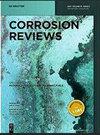不同初始织构状态下Mg–Gd基可溶性镁合金腐蚀机理的研究
IF 3.2
4区 材料科学
Q3 ELECTROCHEMISTRY
引用次数: 0
摘要
摘要为了阐明不同初始织构状态对可溶性镁合金材料腐蚀机理的影响,分别从微观结构、表面形貌、表面电势、浸渍试验和电化学测试等方面研究了铸态和挤压+穿孔(EP)变形的Mg–Gd基可溶性镁合金。结果表明:铸态Mg–Gd基可溶性镁合金的腐蚀速率可达43.85 mg/cm2/h,93 °C wt%KCl溶液,而EP变形后,腐蚀速率大大降低至仅8.37 mg/cm2/h。结合微观组织分析,认为EP变形破坏了铸态组织中的粗网状第二相,降低了第二相的微电偶腐蚀效应。最后,通过对微观结构和腐蚀形态的分析,分别建立了不同初始织构状态下的腐蚀机理模型。研究发现,铸态Mg–Gd基可溶性镁合金的微观腐蚀机制主要为晶间腐蚀,这是微观电偶腐蚀和镁基体溶解的叠加。而变形EP的微观腐蚀机制主要是晶内腐蚀,表现为点蚀。本文章由计算机程序翻译,如有差异,请以英文原文为准。
Study of the corrosion mechanism of Mg–Gd based soluble magnesium alloys with different initial texture states
Abstract In order to clarify the influence of different initial texture states on the corrosion mechanism of soluble Mg alloy materials, the as cast and after extruded + perforated (EP) deformed Mg–Gd based soluble magnesium alloys are investigated by the microstructure, surface morphology, surface volta potential, immersion test and electrochemical measurement separately. The results indicate that: the rate of corrosion of the as cast Mg–Gd based soluble magnesium alloy can reach 43.85 mg/cm2/h at 93 °C in a 3 wt% KCl solution, while after EP deformation the rate of corrosion is greatly reduced to only 8.37 mg/cm2/h. Combined with the microstructure analysis, it is concluded that the EP deformed destroyed the coarse reticulated second phase in the as cast structure, which reduced the micro-electrocouple corrosion effect of the second phase. Finally, the corrosion mechanism models for different initial texture states are established through the analysis of microstructure and corrosion morphology, respectively. It is found that the microscopic corrosion mechanism of the as cast Mg–Gd based soluble magnesium alloy is mainly intercrystalline corrosion, which is a superposition of micro-electrocouple corrosion and Mg matrix dissolution. While the microscopic corrosion mechanism of the EP deformed is mainly intracrystalline corrosion, which is manifested as pitting corrosion.
求助全文
通过发布文献求助,成功后即可免费获取论文全文。
去求助
来源期刊

Corrosion Reviews
工程技术-材料科学:膜
CiteScore
5.20
自引率
3.10%
发文量
44
审稿时长
4.5 months
期刊介绍:
Corrosion Reviews is an international bimonthly journal devoted to critical reviews and, to a lesser extent, outstanding original articles that are key to advancing the understanding and application of corrosion science and engineering in the service of society. Papers may be of a theoretical, experimental or practical nature, provided that they make a significant contribution to knowledge in the field.
 求助内容:
求助内容: 应助结果提醒方式:
应助结果提醒方式:


